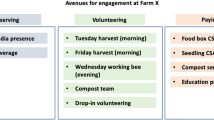Abstract
In the summer of 1915 British women took to the streets of London demanding the right to serve. This ‘Call to the Women’ of Britain was part of a larger campaign that encouraged women to support the war effort by entering the labour force and relieving men for military service. At the beginning of the war women flocked to factories and urban centres hoping to capitalise on the wartime market, but in the winter of 1916 there were rumours of food shortages in the capital and all groups involved in women’s farm labour agreed that a concerted effort was needed to bring more women to the land. While these volunteer organisations did much to encourage enlistment, offer training, and put women to work on British farms, they did not have the support of the Asquith government and lacked central organisation. To coordinate and effectively employ women in agriculture, Lord Selborne, who had been working independently to organise women’s farm labour since 1915, established the Women’s Branch in December 1916 before retiring from his post as minister of food with the Board of Agriculture. The Women’s Land Army was created in 1917 to serve as a central organisation for women’s farm labour and was intended to act as an umbrella for those volunteer organisations already in place. The lack of central coordination, the volunteer nature of early farm and horticulture organisations, the absence of government support, and the divergent tactics employed by the various groups involved undermined the success of these organisations and presented a number of obstacles and challenges for the organisers of the Women’s Land Army (WLA) after 1917.
Access this chapter
Tax calculation will be finalised at checkout
Purchases are for personal use only
Preview
Unable to display preview. Download preview PDF.
Similar content being viewed by others
Notes
C. S. Orwin and E. H. Whetham, History of British Agriculture, 1846–1914 (Newton Abbot: David & Charles, 1971), 341–2
P. Dewey, British Agriculture in the First World War (London: Routledge, 1989), 15–17
P. Dewey, War and Progress: Britain, 1914–1945 (London: Longman, 1997), 19
A. Offer, The First World War: An Agrarian Interpretation (Oxford: Clarendon Press, 1989), 93
J. Sheail, ‘Land Improvement and Reclamation: The Experiences of the First World War in England and Wales’, Agricultural History Review 24: 2 (1976): 111
P. Dewey, ‘Nutrition and Living Standards in Wartime Britain’, in The Upheaval of War: Family, Work and Welfare in Europe, 1914–1918, ed. R. Wall and J. Winter (Cambridge: Cambridge University Press, 1988), 201.
T. H. Middleton, Food Production in War (London: Oxford Clarendon Press, 1923), 86–97.
M. Barnett, British Food Policy during the First World War (Boston: George Allen & Unwin, 1985), xviii–xix
T Wilson, The Myriad Faces of War: Britain and the Great War, 1914–1918 (Cambridge: Polity Press, 1986), 536.
R. Houh, The Great War at Sea, 1914–1918 (Oxford: Oxford University Press, 1984), 307–8.
D. Cannadine, The Decline and Fall of the British Aristocracy (New Haven, CT: Yale University Press, 1990), 72–3.
B. Hibbard, Effects of the Great War Upon Agriculture in the United States and Great Britain (New York: Oxford University Press, 1919), 183
Lord Ernie, English Farming: Past and Present (London: Frank Cass & Co., 1961), 403–8
A. F. Cooper, British Agricultural Policy, 1912–1936: A Study in Conservative Politics (Manchester: Manchester University Press, 1989), 1
M. Olson, The Economics of the Wartime Shortage: A History of British Food Supplies in the Napoleonic War and in World Wars I and II (Durham, NC: Duke University Press, 1963), 73–7
J. Brown, ‘Agricultural Policy and the National Farmers’ Union, 1908–1939’, in Agriculture and Politics in England, 1815–1939, ed. R. J. Wordie (New York: St Martin’s Press, 2000), 182.
J. Kendle, Ireland and the Federal Solution: The Debate over the United Kingdom Constitution, 1870–1921 (Kingston: McGill-Queen’s Press, 1989), 180–2
I. Chambers, The Chamberlains, the Churchills and Ireland, 1874–1922 (London: Cambria Press, 2006), 283–4.
Lord Selborne to H. H. Asquith, 12July 1915, TNA, LAB 2/172/LE1823/81/1915. See B. White, ‘Feeding the War Effort: Agricultural Experiences in First World War Devon’, Agricultural History Review 58 (2010): 95–112.
‘War Agricultural Committees: County Committees’, TNA, 15 September 1915, Board of Trade, MAF 39/23. See also J. Grigg, Lloyd George: War Leader 1916–1918 (London: Penguin, 2005), 129.
See B. White, ‘Volunteerism and Early Recruitment Strategies in Devonshire, August 1914-December 1915’, Historical Journal 53 (2009): 651–2.
Michel Augé-Laribé and Pierre Pinot, Agriculture and Food Policy in France during the War (New Haven, CT: Yale University Press, 1927), 40.
Margaret H. Darrow, French Women and the First World War: War Stories of the Home Front (New York: Berg, 2000), 178–9
C. Twinch, Women on the Land: Their Story during Two World Wars (Cambridge: Lutterworth Press, 1991), 1.
P. Horn, Rural Life in England in the First World War (New York: St Martin’s Press, 1984), 118.
Board of Trade Employment of Women in Agriculture Report, 15 September 1916, TNA, MAF 59/1. The question of substitute labour fits in to a larger debate about workers’ rights and the value of state intervention into industry. See Gerry Rubin, War, Law and Labour (Oxford: Clarendon Press, 1987), 95–6
J. N. Home, Labour at War: France and Britain, 1914–1918 (Oxford: Oxford University Press, 1991), 78–83
B. Waites, A Class Society at War: England 1914–1918 (New York: St Martin’s Press, 1987), 200–1
K. Grieves, The Politics of Manpower, 1914–18 (Manchester: Manchester University Press, 1988), 4
M. Kirby, ‘Industry, Agriculture and Trade Unions’, in The First World War in British History, ed. Stephen Constantine et al. (New York: St Martin’s Press, 1995), 63
Author information
Authors and Affiliations
Copyright information
© 2014 Bonnie White
About this chapter
Cite this chapter
White, B. (2014). Answering the Call: The Formation of the Women’s Land Army. In: The Women’s Land Army in First World War Britain. Palgrave Macmillan, London. https://doi.org/10.1057/9781137363909_2
Download citation
DOI: https://doi.org/10.1057/9781137363909_2
Publisher Name: Palgrave Macmillan, London
Print ISBN: 978-1-349-47314-4
Online ISBN: 978-1-137-36390-9
eBook Packages: Palgrave History CollectionHistory (R0)




